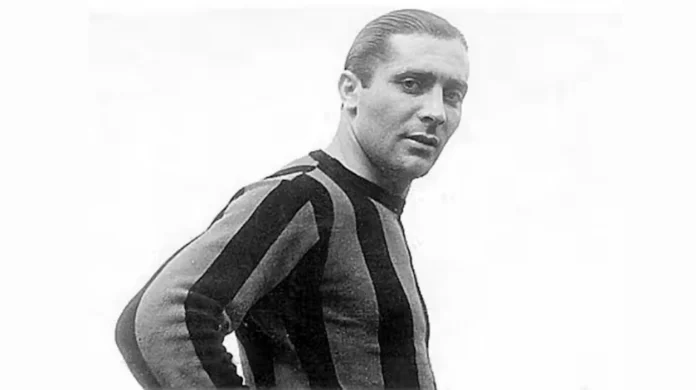Giuseppe Meazza is a bright example in the history of football not only in Italy but also in the world. His success and goal assists during the two consecutive FIFA world cup victories of Italy in 1934 and 1938, not mentioning his notable successes in the club, qualify him as one of the earliest iconic players in the sport.
Mezza was worshiped due to his method, leadership and goal scorer and that is the core of what has turned out to be called the Italian football tradition. To date, his legacy is literally written in Italian culture: the stadium available in Milan with the official name of Stadio Giuseppe Meazza bearing the name of San Siro.
Early life and rise in Milan’s football scene
Meazza was born on August 23, 1910, in Milan, and his early years were in time with the growth of popularity of football throughout Europe. Being an orphan since early childhood, he had to compensate his feelings with the sport and demonstrated an unusual ability in the streets of Milan. His skills made him join the youth academy of Inter Milan at the tender age of 13 years.
He was already in the first team at the age of 17 making his debut in 1927 and scoring twice during his debut. His performances caught headlines fast and in the 192930 season, he was the leading guy in Serie A with a record 31 goals, the first ever in the history of soccer to be so young, and having scored 31 goals in a season.
Dominance in domestic football with Inter Milan
The club career of Meazza is most related with Inter Milan where he played in the period between 1927 and 1940. During 365 games, he scored 243 goals and became the highest scorer in the history of Inter. His contribution to the club was both short term and long term as he helped the club to win three Serenity A titles in 1930, 1938 and 1940. Another crucial role that he played involved winning the Coppa Italia in 1939.
Milestones and scoring records
In the prime of his career, Meazza always dazzled the opposing defenders with a mixture of tricks, balance and scoring. He made several five goal games and could dictate the attacking play which made him a goal scorer and a goal creator. In cases where the Serie A shifted to a different style, Meazza modified his playing style and shifted to deeper roles as the occasion arose.
Later career moves and return to Inter
Meazza left Inter and joined AC Milan, Juventus, Varese, and Atalanta; this proves that he was a very versatile and strong player. His goal scoring went down as he got older but his football intelligence was still there. He later came back to Inter Milan as a player-coach giving strength to his old relationship with the club.
National heroics in World Cup victories
The success of Meazza in the club was reflected on his international career. His first appearance with the Italian national team was in 1930 and he became the center of attack in the team. By the time he was at the 1934 FIFA world cup in Italy, he was already a super star. Coach Vittorio Pozzo, playing under him, enabled Meazza to make Italy win the tournament and the country has been known as a power in international football.
Leadership in 1934 and 1938 tournaments
Meazza’s technical skill and temperament of a big match were revealed when Meazza played in the World Cup campaigns of Italy. He made a decisive contribution in a number of matches in 1934, scoring and assisting at the right time. Four years later, he led Italy in its success in defense of the title in France. His calm and demeanour even in a high stress match like the semifinal against Brazil, helped to hone his reputation as an exceptionally calm footballer.
Iconic moments and legacy
Another incident that Meazza is best remembered for was the penalty that he scored against Brazil in the 1938 semifinal as he converted it with one hand despite a wardrobe malfunction that he had to use the other hand to hold the shorts up. This was a summary of his light and heavy marks of playing and character.
Hallmarks of his playing style and influence
Since he was referred to as Il Genio (The Genius) by his teammates, Meazza was known to have an elegant touch, tactical intelligence and the ability to perform under pressure. He favored playing as a center forward, attacking midfielder or second striker, with the vision and creativity that characterized modern concepts of these positions.
Technical excellence and adaptability
Meazza had exceptional two-footedness enabling him to shoot or pass equally on either side. He was classy and efficient at dribbling and also a good reader of the game and this attribute enabled him to provide more than just simple goal-scoring. The fact that he has been able to adjust despite age also added years to his top-level career, serving as a role model to other players of different generations.
Influence on Italian football identity
Combining technical skillfulness and incessant rivalry, Meazza became the ideal of the Italian forward. His style made a difference in generations of Italian strikers, starting with Silvio Piola up to the time of Roberto Baggio. His focus on smarts and prowess in the realm of football served to define a unique style of play in Italy in the 20th century.
Coaching career and continued contributions
After retiring, Meazza shifted into coaching where he used his extensive knowledge of the sport in the management sphere. He was the manager of Inter Milan on several occasions and managed the Italian national team and Turkish club Besiktas. His coaching career, however, raised the profile of the soccer legend, though it was not as glorified as his playing career, as it made him able to coach up-and-coming talents.
Honors and stadium renaming
A decade after his death, in 1980, the legendary San Siro stadium was renamed Stadio Giuseppe Meazza in his honour in Milan. This was a symbolic decision, not only of his relationship with Inter Milan, but of his height in Italian football, in general. In 2011, he became a member of the Italian Football Hall of Fame, which helped him to establish himself as one of the most hallowed sports celebrities of the country.
Giuseppe Meazza’s legacy in 2025 and beyond
Almost one century after his debut, the legacy of Meazza is still a significant aspect of Italian football. By 2025, not only the name of the stadium where two of the largest clubs in the country play sports is synonymous with his name, but also the standards of excellence in international football.
The two world cup wins remain a unique feat, and the part he played in the wins has been examined and glorified by historians, coaches, and other fans. The image of Meazza in many cases is mentioned when the great tournaments are conducted because it represents the origin of Italian success in football. His story reminds us of the way driving forces can influence the genes of a national sport.
With the game of football continually changing in digital, business, and tactical aspects, the example of Giuseppe Meazza remains intact as a standard of eternal virtues: creativity, leadership and grace under pressure. This is exemplified in his career as the impact of a player can transcend beyond records to being a part of a cultural story that determines what football is to a nation and its citizens.










